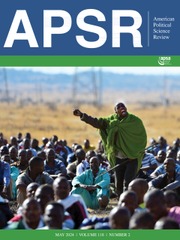Article contents
Some Ambiguities in the Notion of Power*
Published online by Cambridge University Press: 02 September 2013
Extract
The notion of power is often said to be central to the analysis of politics. But while that analysis is a very ancient activity, the conceptual clarification of the notion of power has been undertaken only in the past generation. The reason for this discrepancy I leave to the historians of political ideas. In this introduction I merely observe that the clarification has not proceeded as far as is needed, so that we are still not at all sure of what we are talking about when we use the term. Nevertheless there is light ahead, owing especially to some formal definitions that have been offered in recent years by Shapley and Shubik, March, Dahl, Cartwright, and Karlsson. By reason of the formality of these definitions the issues of meaning have been more sharply delineated than was previously possible. Hence we have reached the point, I believe, where we may confront definitions with each other and specify precisely how they differ. In so doing we may be able to resolve some of the ambiguities remaining in the concept of power. In that hope this essay is written.
Information
- Type
- Research Article
- Information
- Copyright
- Copyright © American Political Science Association 1964
References
1 Shapley, L. S. and Shubik, Martin, “A Method for Evaluating the Distribution of Power in a Committee System,” this Review, Vol. 48 (1954), pp. 787–92Google Scholar; Shapley, L. S., “A Value for N-Person Games,” Annals of Mathematics Study No. 28 (Princeton, 1953), pp. 307–17Google Scholar and “Simple Games,” Behavioral Science, Vol. 7 (1962), pp. 59–66Google Scholar.
2 March, James G., “Measurement Concepts in the Theory of Influence,” Journal of Politics, Vol. 19 (1957), pp. 202–226CrossRefGoogle Scholar; see also his “An Introduction to the Theory and Measurement of Influence,” this Review, Vol. 49 (1955), pp. 431–51Google Scholar.
3 Dahl, Robert A., “The Concept of Power,” Behavioral Science, Vol. 2 (1957), pp. 201–15, at pp. 202–03CrossRefGoogle Scholar. Note that Harsanyi has modified Dahl's definition (and also Shapley's) by adding opportunity costs. Since these modifications do not affect the basic theory, I have not discussed them here. Harsanyi, John C., “Measurement of Social Power, Opportunity Costs, and the Theory of Two-Person Bargaining Games,” and “Measurement of Social Power in N-Person Reciprocal Power Situations,” Behavioral Science, Vol. 7 (1962), pp. 67–80, 81–92CrossRefGoogle ScholarPubMed.
4 Cartwright, Dorwin, “A Field Theoretical Conception of Power,” pp. 183–220Google Scholar, in Cartwright, Dorwin, ed., Studies in Social Power (Ann Arbor, 1959)Google Scholar.
5 Karlsson, Georg, “Some Aspects of Power in Small Groups,” in Criswell, Joan H., Solomon, Herbert, and Suppes, Patrick (eds.), Mathematical Methods in Small Group Processes (Stanford, 1962), pp. 193–202Google Scholar.
6 If Cartwright's force to comply, f ab, and force to resist, ![]() , could be translated into conditional probabilities of compliance and resistance, then Cartwright's definition would be exactly the same as Dahl's formula, p1–p2.
, could be translated into conditional probabilities of compliance and resistance, then Cartwright's definition would be exactly the same as Dahl's formula, p1–p2.
7 Gasking, Douglas, “Causation and Recipes,” Mind, Vol. 64 (1955), pp. 479–87CrossRefGoogle Scholar.
8 Riker, William H., “Causes of Events,” The Journal of Philosophy, Vol. 55 (1958), pp. 281–91CrossRefGoogle Scholar. This essay depends for its terminology on my “Events and Situations,” The Journal of Philosophy, Vol. 54 (1957) pp. 57–90CrossRefGoogle Scholar.
9 Simon, Herbert, Models of Man (New York, 1957), chap, 1, 3Google Scholar.
10 Warnock, G. J., “‘Every Event Has a Cause’” in Flew, Anthony, ed., Logic and Language, Second Series (Oxford, 1953) p. 101 ffGoogle Scholar.
11 But see the addendum of this paper for evidence of a manipulative element in their definition.
12 Bachrach, Peter and Baratz, Morton, “Two Faces of Power,” this Review, Vol. 56 (1962), pp. 957–52Google Scholar.
13 Singer, J. David, “Internation Influence,” this Review, Vol. 57 (1963), pp. 420–30Google Scholar.
- 55
- Cited by


Comments
No Comments have been published for this article.